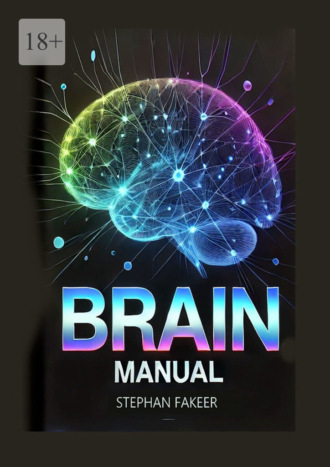
Полная версия
Brain. Manual

Brain. Manual
Stephan Fakeer
Illustrator Stephan Fakeer
© Stephan Fakeer, 2025
© Stephan Fakeer, illustrations, 2025
ISBN 978-5-0067-4267-3
Created with Ridero smart publishing system
Congratulations! You are now the proud owner of the most brilliant organ on the planet. Yes, that’s right – your brain! That magical thing that dreams, creates, imagines, solves problems, and (usually) keeps you from forgetting your keys at home. Thanks to its tireless work, you are you! And it has the power to take you to incredible creative heights. Rest assured – your brain is absolutely one of a kind.
Shaped by a unique mix of genes, experiences, environment, and education, it makes your thoughts and talents as original as itself. This remarkable organ comes with limitless potential.
Your brain is your personal HQ for thoughts, memories, emotions, and creative outbursts. Its superpower? The ability to change and adapt (yes, that’s neuroplasticity!) – helping you learn, grow, and even come up with excuses when you’re late for meetings.
Oh, and one more thing: your brain is so precious that nature wrapped it in a sturdy skull and installed a blood-brain barrier – just in case your immune system ever gets… creative and decides to turn against you.
SPECIFICATIONS
– Weight: 1 to 2kg, averaging 1,340g (Your brain is almost 1.5kg of pure potential, unless you’re on a diet of course).
– Composition: 60% fat. (Yes, most of your thoughts are born in fat).
– Fuel: Glucose and oxygen, greedily absorbing up to 25% of your body’s energy. (So while you’re sitting still, your brain is having a feast).
– Blood vessels: If stretched in a single line, they would circle the Earth four times – over 160,000 kilometres! (Obviously your brain is a traveller, even if it rarely leaves your skull).
– Neurons: Over 100 billion – enough for a lively “party’. Each neuron is like a smartphone, so technically your brain has more “devices’ than the entire planet.
– Axons: Trillions of them connect neurons, with a total length of about 1 million kilometres – that’s like three trips to the moon and back. (Apparently your brain has a secret deal with NASA).
– Nerve fibres: 500,000 kilometres. (That’s practically the entire Rostelecom internet network, but inside your head).
– Cortical area: 20 square metres. (That’s the size of a cosy studio flat!)
– Nerve impulse speed: 288 kilometres per hour. (Faster than the moment you realise you forgot to buy milk).
– Memory capacity: 2.5 to 6 petabytes. That’s enough to watch HD films non-stop for 300 years! (Yes, that’s a lot more than your computer can store.)
1. Brain Structure – Simply Explained
Imagine a massive forest, say, somewhere in Siberia – a sprawling taiga filled with all kinds of trees. Each tree represents a neuron, the main nerve cell in your brain. And the number of neurons in your head rivals the number of trees in the Siberian taiga – over 100 billion. Impressive, right? Oh, and here’s the kicker: every tree has its own high-tech smartphone, and there are more of these in your brain than there are smartphones on Earth.
Just like in the taiga, neurons come in all sorts: pines, spruces, firs, and birches. One neuron handles vision, another takes care of smell, and a third makes sure you can move your legs. Imagine a birch grove as your sense of smell, while the pine forest is your ability to sprint for the bus. Every tree stays in its own area and doesn’t meddle in its neighbor’s business.
But trees won’t thrive without care. That’s where the gardeners, called glial cells, step in. They feed the trees, water them, supply oxygen, and even clean up fallen leaves. There’s one gardener for every tree, ensuring that each neuron is in good hands.
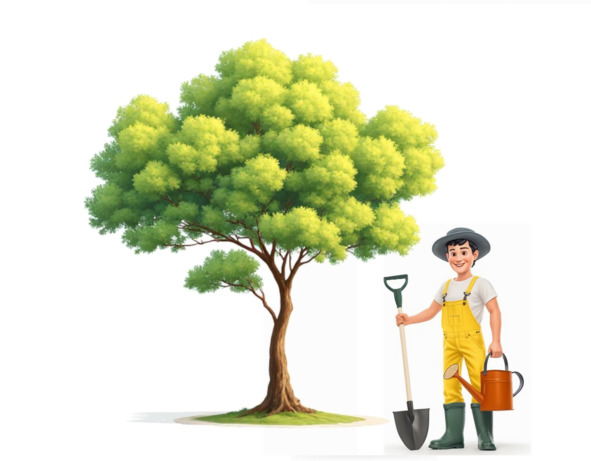
However, a single tree without its neighbors is just a tree – not a forest. Your brain thinks and functions only when neurons connect into an immense network, like a forest where every tree is linked to countless others. One tree (or neuron) can have up to a million such connections, all constantly communicating with each other – and sometimes even with your organs. Truly, a forest of thought!
The cerebral cortex is a six-story forest. It’s not just the width but also the height that matters! Each “floor” of this forest has its own important role. The more trees in a specific area, the greater a person’s natural abilities, which, with the right effort, can grow into talents. That’s how geniuses are born: Pyotr Tchaikovsky, Grigori Perelman, Sergey Korolev, Igor Sikorsky, Pavel Durov. Look at what neurons can accomplish when they’re properly nurtured!

2. Neurons – Trees and Smartphones
To make it easier to picture, imagine a neuron as a tree. It has roots, a trunk, branches, and leaves. The roots are the dendrites, which receive information and pass it to the tree (neuron). The trunk is the axon, connecting the tree to other trees (neurons) or to the body’s organs. The branches are the synapses, the communication hubs between trees (neurons), and the leaves are the neurotransmitters, sending signals across the synapse.
And if we imagine that the tree has a smartphone, that would be the soma – the neuron’s nucleus, responsible for keeping all vital functions in check.
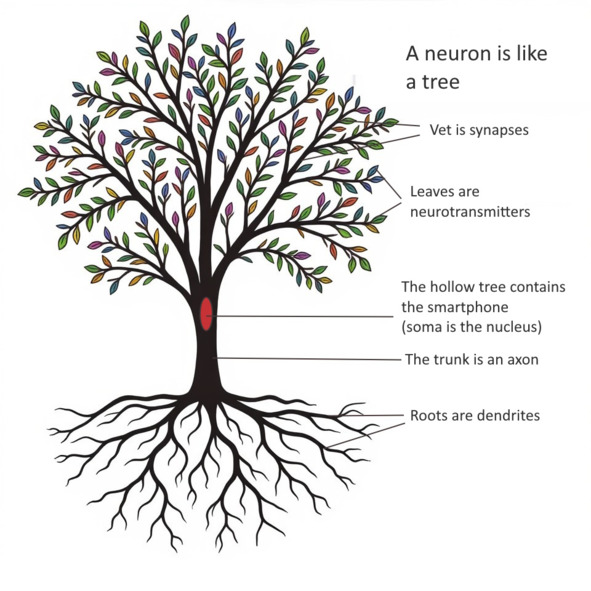
Trees (Neurons) Come in Many Varieties
Trees (neurons) come in over 200 different “species,” each with its own “purpose” and “design.” They communicate with one another using electric impulses and chemical signals – and they do it at mind-blowing speed.
The roots (dendrites) of a tree receive information from the branches and leaves of other trees (neurons). This information is sent to the tree’s smartphone – the soma, or the nucleus of the neuron – where it’s processed. Then, the message is transmitted through the tree’s trunk (axon), branches, and leaves to other trees. And voilà, across the whole forest – or let’s say the taiga of your brain – a full-blown search operation begins! Memory zones get activated, and boom – the thought process is in full swing.
Roots (dendrites) and branches (synapses) grow endlessly – from birth until the very twilight years. They’re constantly seeking new connections and solutions. But here’s the rub: when certain brain regions sit idle for too long, these connections start breaking down, like old ropes. This is where our gardeners, the glial cells, step in – they happily recycle the remnants of those lost connections to clear space.
The smartphone (soma – the nucleus of the neuron) acts as the control center for the entire tree (neuron). From here, all the orders are issued: when to supply energy, how to grow, how to build new connections with other trees, and what to do with the information received. It’s essentially the manager of the forest, always in the know.
The trunk (axon) is a one-of-a-kind powerhouse and can be over a meter long – like the one responsible for moving your little toe. It’s covered in a protective “bark” (myelin), and the thicker the bark, the faster the signal travels. If there’s lots of traffic, the bark gets thicker. But if not, it thins out, which can lead to problems – sometimes so severe the trunk might even stop working altogether.
Branches (synapses) act like wires, connecting neurons to other neurons and body organs. These branches link up with the roots (dendrites) of other trees (neurons) or with muscles and organs. And here’s the crazy part – up to 150 billion of these wires can work at the same time! So when you’re solving an important problem or delivering a lecture to a room full of students, all these synapses are firing at full capacity, like a giant Siberian taiga working overtime just for you.
Leaves (neurotransmitters) are the real magicians of the thought process. These tiny marvels sit at the tips of the branches and roots of the trees. What’s fascinating is that they don’t actually touch each other. Instead, they leave a tiny space between them where a spectacular electro-chemical show unfolds – like a symphony orchestra performing at every connection. And believe it or not, trillions of these orchestras are playing simultaneously. That’s how thoughts are born!
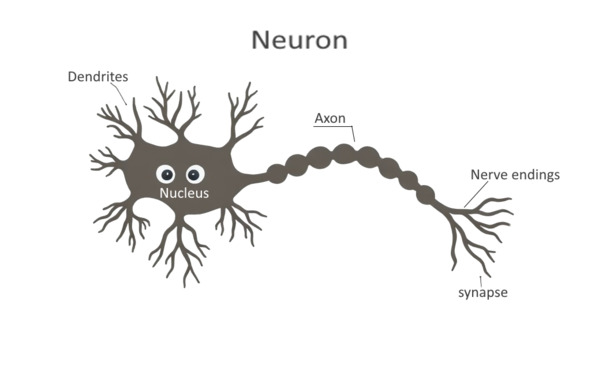
3. The Limbic System – Your “I Want”
The mountains of our brain landscape emerged long before the forests, just like the limbic system – a primordial structure that predates our shiny new neocortex. Think of the limbic system as those ancient mountains, occupying 20% of the brain’s area and consuming 10% of the body’s energy. Within these neural mountains (trees), there are four times more neurons than in the neocortex. This is where all the magic happens – breathing, eating, and yes, even that sudden, head-over-heels feeling of falling in love.
These mountains (limbs) handle reflexes and emotions for us. They work on autopilot: you slip but don’t fall, dodge a snowball without thinking, grab a hot pan and immediately let go. It all happens without your conscious input. Feeling tired? They’ll send you to bed to recharge. And of course, they nudge you toward romance and family life – because let’s face it, love runs the show. All incoming information passes through these mountains, and outgoing commands to muscles and organs travel the same path.
The mountains work around the clock, creating emotional wonders like joy, fear, love, or disappointment. They also fine-tune your blood pressure, manage pain, and act like a maestro conducting the orchestra of your body.
Let’s take a hike through some highlights of these mountains:
The Cerebellum – About the size of a ping-pong ball, this little powerhouse is a command center in its own right. Here, neurons are four times more plentiful than in the neocortex, and they’re tinier than you can imagine. The cerebellum is in charge of all your movements – from perfect penmanship to acing a tennis serve. Without it, playing a virtuoso piano solo would be impossible!
Thalamus – The modest walnut that acts as the grand central hub for all sensory signals – except smell. It’s your brain’s tireless “postman,” delivering signals back and forth between the brain and the body with precision and speed.
Amygdala – These two almond-shaped buddies, tucked away in your temporal lobes on both the left and right sides, are the ultimate emotion processors. They don’t just react to your emotions – they save them to memory. Fear, the superstar survival emotion, is their primary concern. Visual, auditory, olfactory, or pain-related signals flood in, get processed, and trigger orders to your muscles and cardiovascular system: freeze or flee, as stress hormones leap into action.
Hippocampus – A twin organ resembling a seahorse, the hippocampus is your trusty navigator for memory and spatial orientation. Without it, you’d have a hard time remembering where you left your keys or how to find your way home!
Hypothalamus – At just 4 grams, this little powerhouse runs your body’s life cycles. Deep within the hypothalamic-pituitary system, it produces endogenous opiates – your body’s natural feel-good chemicals. With these, it regulates emotions, motivation, attachment, habits, stress, and pain, as well as hunger and satiety. A multitasking maestro!
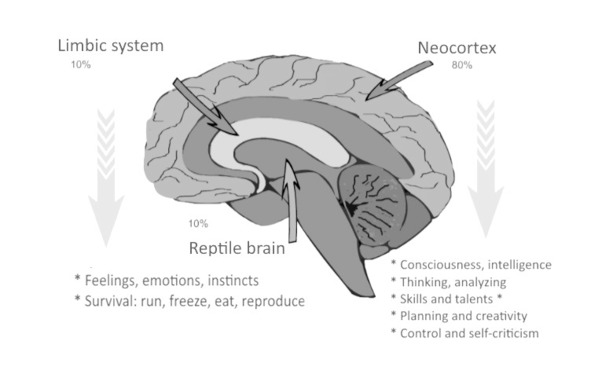
Hypophysis – The boss of the endocrine system. This tiny overlord produces hormones that govern nearly every aspect of life: cell regeneration, stress and pain management, love, milk production, and even sexual development. A true ruler of the body’s inner kingdom!
In summary: The limbic system is the guardian of our health, survival, reflexes, and emotions. It works automatically, beyond our control, from the moment of our birth until our last breath. In those final moments, it sends powerful impulses to the lungs, heart, and other organs, making one last attempt to sustain life.
Taking up 20% of the brain’s volume and consuming 10% of the body’s energy, the limbic system is essential. It can even override the rational part of the brain in critical situations, prioritizing survival. However, a well-trained human mind has the potential to regulate and influence the limbic system’s functions.
4. Neocortex – Your “Must-Do” Brain
The neocortex is the cerebral cortex, resembling a forest of trees (neurons) marked by grooves and ridges. Picture a meticulously organized forest, where every patch is dedicated to a specific skill or function. When these areas work together in harmony, they can nurture talents – and even brilliance.
It’s within this “forest” that the talents of Tchaikovsky, Pushkin, Mendeleev, and other remarkable minds flourished. Without their neocortex, we might never have had breathtaking symphonies or, say, the Periodic Table.
Although the neocortex makes up 80% of the brain, it has four times fewer neurons (trees) than the limbic system. Yet, it guzzles energy at an impressive rate – consuming up to 25% of the body’s total reserves. Why? Because this is where the magic happens: thinking, analyzing, creating. Every brilliant (and not-so-brilliant) idea, from solving complex equations to pondering the culinary masterpiece that is pineapple pizza, is born here.
This is the headquarters of all human activity: thinking, calculating, imagining, and decision-making. Information from your senses – sight, hearing, smell, touch – is funneled here for processing, leading to actions and decisions. It’s the control center for complex intellectual processes, the very essence of what makes us human.
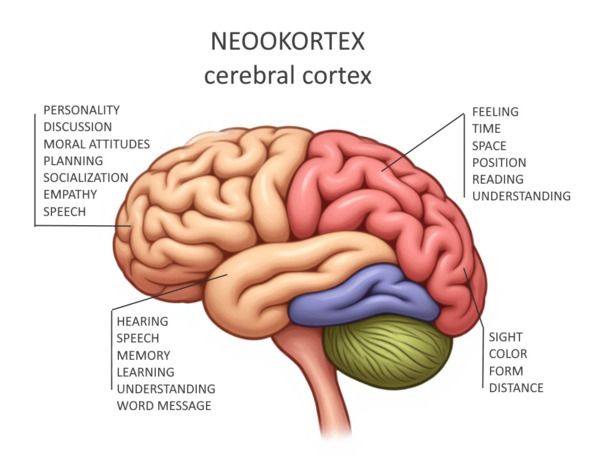
The Cortex (The Taiga): The Brain’s Most Complex Landscape
The cortex, our cerebral “taiga,” is the brain’s most intricate structure. It boasts up to six layers of neural tissue, each featuring unique types of neurons connected to various regions of the cortex, the limbic system, the subcortical layers, and countless other parts of the brain. No two brains are alike – every person’s cortex is as unique as their fingerprint.
Let’s take a stroll through some key districts of this neural forest:
The Prefrontal Lobes
Located just behind your forehead, these are your brain’s command center. This is where the most complex cognitive processes take place: thinking, doubting, analyzing, and making decisions. Fun fact: these lobes don’t fully “power up” until around age 27, so don’t worry if rational thinking wasn’t your strong suit in your younger years.
Want to test your prefrontal lobes? Try these simple tasks:
– Recite the alphabet backward.
– Pretend to play the piano on a regular table, using all ten fingers from thumb to pinky.
– Perform mental math like subtraction, division, multiplication, or summation.
– Imagine the life of a single teacher with two kids living in a small-town province.
If you succeeded, congratulations – your prefrontal lobes are in great shape!
The Temporal Lobes: The Brain’s Language Gurus
Nestled near your ears, the temporal lobes are your go-to specialists for hearing and language. They take all the auditory and written signals you encounter and decode them into meaningful words. Damage this area, and the ability to understand speech may be lost – a sobering reminder of how crucial they are.
But these lobes don’t work alone; they collaborate with the hippocampus and the amygdala like a well-tuned rock band, transforming your experiences into long-term memories. They also process visual information received from the occipital lobes, turning raw data into digestible insights.
Kids who grow up hearing multiple languages collect “brain bonuses.” Later in life, they breeze through learning new languages. Likewise, early exposure to music can nurture the seeds of a virtuoso musician, making adult mastery of instruments and melodies far more likely.
The Parietal Lobes: Coordination Masters
Think of the parietal lobes as your brain’s party planners for coordination. Imagine a tea party: a steaming samovar, delicate cups, saucers, spoons, candies, and of course, jam. You pour tea onto your saucer, but oh no! A drop of hot tea spills onto your hand. Instantly, you pull your hand back. That’s your parietal cortex flexing its superpowers.
It swiftly calculated the shapes of the cup and saucer, the distance to your hand, and then rewrote the plan as soon as your skin sent a distress signal – all within seconds.
Parietal lobes are the ultimate magicians, turning sensory data – touch, sound, sight, and even pain – into meaningful actions. Plus, they play a key role in speech comprehension and production. Without their help, your tea party conversation wouldn’t flow nearly as smoothly!
The Occipital Lobes: Vision Commandos
These guys are your vision specialists. Thanks to them, you’re reading this text right now without losing track of the letters. Everything your eyes see gets converted into electrical impulses, which the occipital lobes analyze in record time.
They assess colors, shapes, sizes, and distances in the blink of an eye. They even recognize familiar faces and movements, like a friend waving at you or a fast-approaching ball that you better dodge!
These rapid responders don’t waste a moment, passing their calculations to other brain regions to turn them into priceless visual memories. Whether it’s reading a book or recognizing a sunset, your occipital lobes have your back.
5. Birth, Childhood, School: The Beginning of the Brain’s Journey

We come into this world with a preloaded “factory setting” for our brains. Crying, grabbing, chewing, swallowing, moving, looking, smelling, and feeling – these skills come standard, no instructions required. From day one, the brain demands its “fuel” – food, sleep, and physical activity – to keep all the body’s systems running smoothly. Like any high-tech device, the brain needs regular charging and rebooting to function optimally.
The brain’s journey begins even before a mother realizes its existence – just three weeks after fertilization, the first “trees” (neurons) begin to sprout. From there, they grow roots, trunks, and branches (a.k.a. synapses, axons, and dendrites). During this developmental boom, neurons are produced at cosmic speeds—250,000 per minute! Connections between them (synapses) proliferate at hundreds of millions per minute, creating a construction frenzy within the developing brain.
The DNA Blueprint: Instructions for Assembly
DNA acts as the “assembly manual” for every cell in the body. Neurons meticulously follow these instructions, taking their places, forming connections with fellow neurons and organs, and maturing until about age 20. However, from the moment we’re born, the total number of neurons begins to decline – there’s no restocking. What grows, grows, and that’s it.
The First Three Years: A Sensory Explosion
After birth, the brain finishes its “initial assembly” and shifts to the sensory stage, developing through all five senses: hearing, vision, touch, smell, and taste. During the first three years of life, the brain buzzes with activity, forming new neural connections and constantly rewiring old ones. It’s a neural gold rush!
By age three, a child’s brain boasts over a quadrillion (a million billion!) connections – about 15,000 per neuron. But it’s not all sunshine and neural growth. Over time, the brain initiates a massive clean-up operation, ruthlessly pruning unused connections. This process, known as synaptic pruning, clears the clutter, leaving only the pathways that are regularly used.
Neural Pruning: Use It or Lose It
Active neural connections grow stronger, like well-worn trails in a forest, while inactive neurons lose their “support” and eventually perish. The brain takes no prisoners – if a neuron isn’t pulling its weight, it gets cut off. But there’s good news: the brain is a master of adaptation. If one sense or function falters, neurons can retrain themselves to assist other areas. This incredible ability to reorganize and adapt is called neuroplasticity.
So, from the very start, the brain proves itself to be a dynamic, ever-changing marvel, constantly building, refining, and optimizing itself for the challenges of life.
The Brain’s Development: Culture and Environment as Architects
The brain’s growth heavily depends on culture and environment. Family, friends, daycare, school, TV, and even the internet all play crucial roles in shaping neural connections. Research has shown that:
– A child who doesn’t hear human speech during their early years won’t learn to speak, no matter how much effort is made later.
– A “wild” child, like Mowgli, who grows up outside of human society, struggles immensely to adapt to social norms later in life.
– And a bonus: children exposed to foreign languages and music in early childhood tend to learn them much faster as adults.
Humans are unique among living beings for having the longest period of childhood and adolescence. This extended timeframe is essential for the brain to develop higher consciousness and intelligence. The bigger the brain, the more time it requires to hone its capabilities.
In the first months of life, neural pathways associated with smell, vision, and hearing form at lightning speed. Later, the brain shifts its focus to more complex tasks – cognitive functions. However, the speed of connection-building varies across different regions of the brain: some processes happen in an instant, while others simmer slowly, like a stew on a low flame.
The Secret Recipe for a Thriving Brain
The blueprint for brain construction is written in our DNA and begins unfolding right after conception. But here’s the catch: for the brain to function like a Swiss watch and unleash its full potential, the right conditions are essential. A warm and nurturing environment, nutritious food, quality education, and opportunities to gather firsthand experiences are all critical.
Cultural exposure is the ultimate brain booster! Books, museums, theaters, travels, languages, and even the internet contribute to sharpening cognitive superpowers. With the right environment, the brain not only grows but thrives, transforming its immense potential into intelligence, creativity, and talent.
6. Feeding the Brain: Energy and Nutrition
The brain is a true energy-hungry genius! Despite accounting for just 2% of body weight, it consumes up to 25% of the body’s total energy, using a modest 14 watts per hour – less than a standard light bulb. For comparison, even the most advanced supercomputers require a million times more energy, yet they still can’t match the complexity of the brain’s work.
Fuel for the Mind
The brain’s favorite energy source is glucose. Through its reaction with oxygen, glucose nourishes neurons (the “trees” of our brain forest). To function properly, the brain requires about 120 grams of glucose daily. However, there’s a catch: refined sugar is no friend of the brain. Far from helping, it subtly undermines our central command center!



